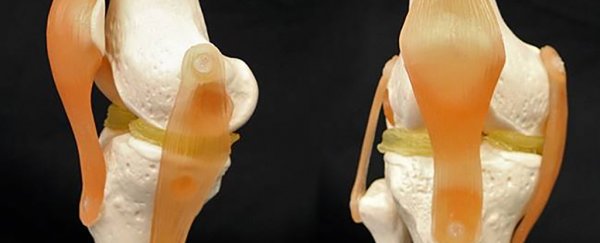A new cartilage-like hydrogel material could make the job of repairing knees much easier, say scientists, as it's 3D printable and can be made as an exact fit for each individual knee.
The new research focuses on the two crucial shock absorbers inside the knee, known as the menisci, and replacing these parts of our bodies needs both the right material properties and the right shape.
That's a challenge the scientists from Duke University have taken up, showing that a suitable hydrogel meniscus can be produced by a 3D printer costing US$300 in just a day.
If that feat can be replicated on a larger scale, we're looking at simple and inexpensive knee repairs for what are usually complex and problematic injuries.
"We've made it very easy now for anyone to print something that is pretty close in its mechanical properties to cartilage, in a relatively simple and inexpensive process," says one of the researchers, Benjamin Wiley.
Each of our knees has two ear-shaped menisci, sitting between the thigh and shin bones, and cushioning every step we take. If these supports get damaged, walking becomes painful and the risk of arthritis increases.
When we reach adulthood, these menisci can't really heal themselves, and broken ones often have to be replaced by surgeons. The trouble is, today's implants aren't as strong or elastic as the real thing, or do nothing to aid healing around the knee.
What's more, the meniscus is made up of two complementary layers – a stiff middle and a soft outer layer – which complicates attempts to develop something that can be 3D printed from just a single material.
To get around this, scientists combined both a strong hydrogel and a stretchable hydrogel together to try and get a material as close to cartilage as possible. They also added a nanoparticle clay to make the substance runny under stress but quick to harden.
"The two networks are woven into each other," explains another of the team, Feichen Yang. "And that makes the whole material extremely strong."
Scientists are warming up to the idea of using hydrogels like these as cartilage replacements, because they share certain properties: take a close look at either, and you'll see a web of long string-like molecules with water molecules wedged in between.
Plus, as we know from other research, the beauty of 3D printing in medical health is that replacement body parts can be made to order, just the right size and shape for a patient, and that's particularly important here.
"Shape is a huge deal for the meniscus," says Wiley. "This thing is under a lot of pressure, and if it doesn't fit you perfectly it could potentially slide out, or be debilitating or painful."

Through computer tomography (CT) or magnetic resonance imaging ( MRI) scans, doctors can work out how implants need to be designed and then feed that information into a 3D printer, as long as we have artificial materials that can do as good a job as natural ones.
The researchers admit it's early days for this "young field" of research, but the menisci demo shows the potential of hydrogels to simplify knee repairs.
We now know it's possible to develop hydrogels with similar properties to cartilage that can also be manipulated with a budget 3D printer. With future study, printable materials even closer to human tissue could be developed.
"I hope that demonstrating the ease with which this can be done will help get a lot of other people interested in making more realistic printable hydrogels," says Wiley.
The research has been printed in ACS Biomaterials Science and Engineering.
